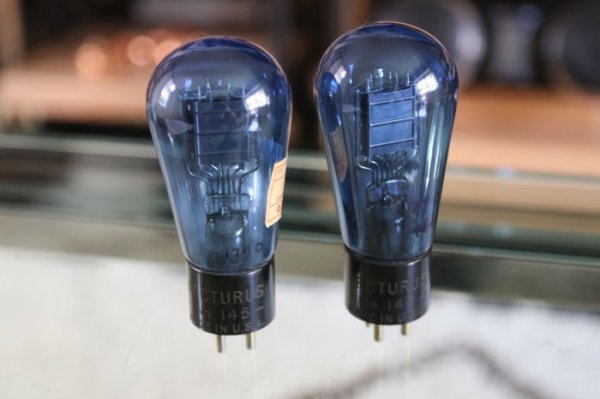Read the previous posts Larry.
Thanks. I see one for sale at t/c for $27.00 Chatham 5R4WGA - ceramic base "potato masher". Larry
Read the previous posts Larry.
Thanks. I see one for sale at t/c for $27.00 Chatham 5R4WGA - ceramic base "potato masher". Larry
Thank you for all that information Norman.
My technical knowledge is limited, but presumably, the5R4WGA / 5R4WGB / 5R4WGY valves output the same voltage and current as a 5U4G?
is there a difference between the 5R4WGA and 5R4WGB?
5R4WGA / 5R4WGB / 5R4WGY
(WGB=gray base) (WGY=brown base)
https://www.tubeworld.com/5r4.htm
also:
No difference. The 'real' Chatham 5R4 is the potato masher, you know, the really ugly flat top one that could be used to take over an airplane. Super thick glass, big ugly ceramic base 9either tan color or grey).
The ones I have are designated 5R4WGY. Later potato mashers made by Cetron don't sound as good.
Ditto. Mine are the tan base ones. Good sound from these ass-ugly rectifiers. I must admit I prefer the Brimar globes I have just because of their sexy good looks, but the potato mashers are quieter and have better bass. They're cheap too, I bought a half-dozen on eBay for $15, hard to go wrong with that...
========================================
Finally:
Hello ,
I have two pairs of this rectifier tubes is there any differents between them or i can use four 5R4GA instead of two 5R4WGB.
THX
===================
The W code indicates special factory processing OR testing for military applications. There is no functional or performance difference between W and non-W.
The G code refers to the shape of the glass envelope.
The A code usually means that the tube is a revised design introduced sometime after the tube had been in production - usually to address some problem, or to make the tube suitable for a wider range of applications. However in this case it principally means a different shape glass envelope - smaller with parallel sides instead of a shoulder bulge.
The B code would also mean a design change, but I was unable in a quick search to find out what it is.
You would not use four of one sort of 5R4 instead of two of another sort.
You can easily check tube ratings at www.radiomuseum.org
===================================
The 5R4WGB was a ruggedized version of the 5R4GB specifically designed for use in military B52 bomber aircraft. It has an unusual shape, thick glass, and a molded base that extends partially up the sides of the glass. This shape has given it the nickname "potato masher". Because of its shape the 5R4WGB may not fit in applications designed for the 5R4GA or 5R4GB. The 5R4GB is an upgraded spec version of the 5R4GA. I believe the spec change is the PIV and peak plate current rating, but I am not sure. Verify before substituting.
All of these tubes are dual rectifier diodes with a common cathode. and all have similar plate current ratings. If you are contemplating using two paralleled 5R4GA's in place of one 5R4WGB, this may be possible, but may not be necessary. Check the plate current, peak plate current, and PIV ratings against your application.
The 5R4 types are particularly sensitive to the value of the input filter cap in 50 or 60 Hz applications. I have seen them spark out on start up even with the suggested cap value.

Close enough for you not to care and go ahead and try it.
thanks Jason
Thanks Norman
I have been in touch with them
the seller said....
"Hi Dave very sorry we could not send the one in the original picture. This was our last one. It was indeed made by Chatham USA and rebranded by Haltron UK
CV717 is the military number for all 5R4"
the test numbers on the box I have show; 66 67 - what does that mean exactly?
It means that both halves of the rectifier are functioning almost identically, I would imagine. They usually quote a minimum good value along with it.
How are you finding it sonically in your system?

